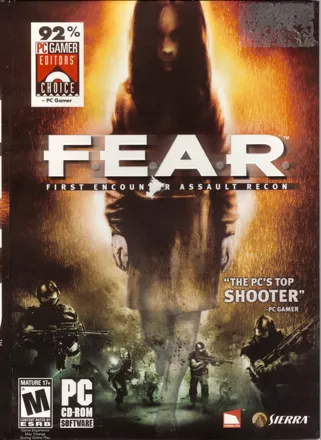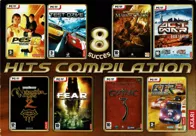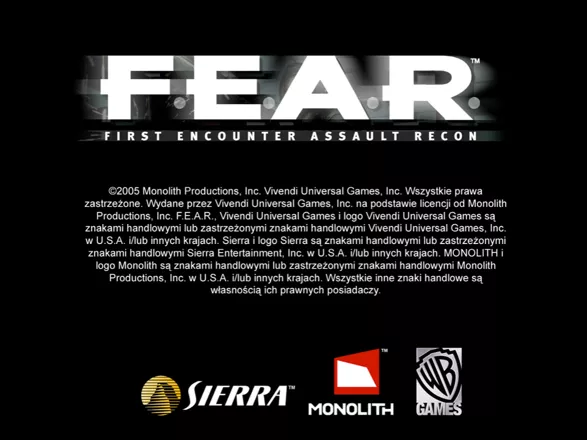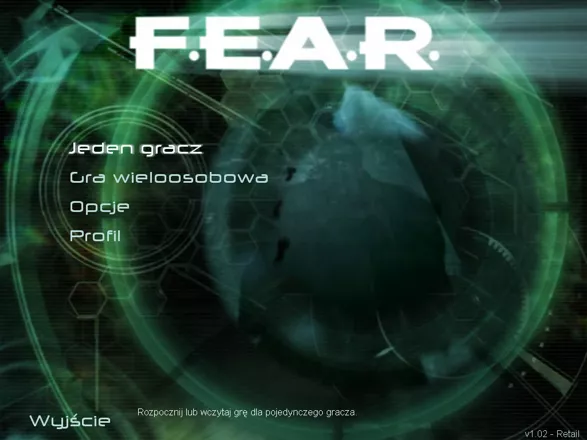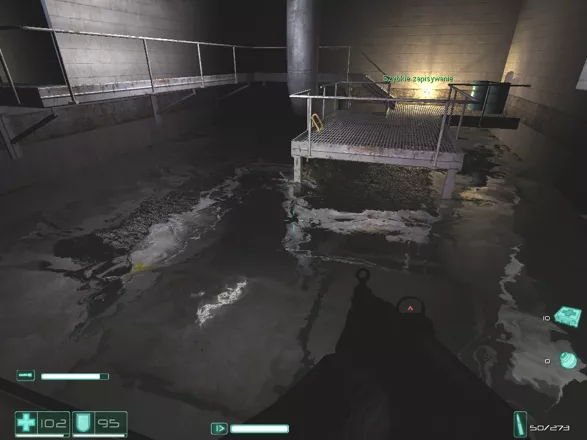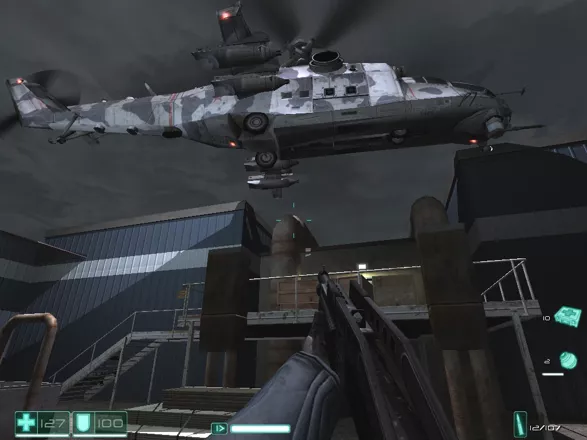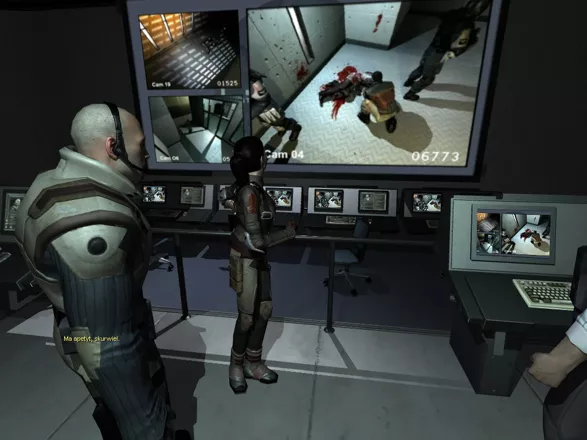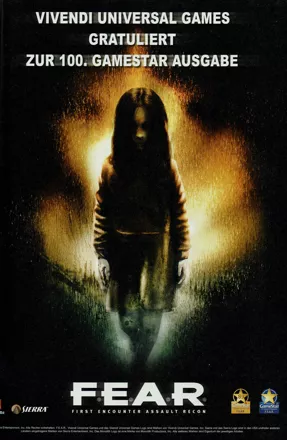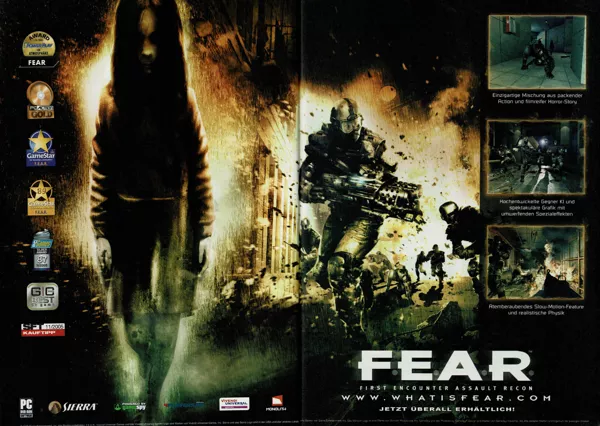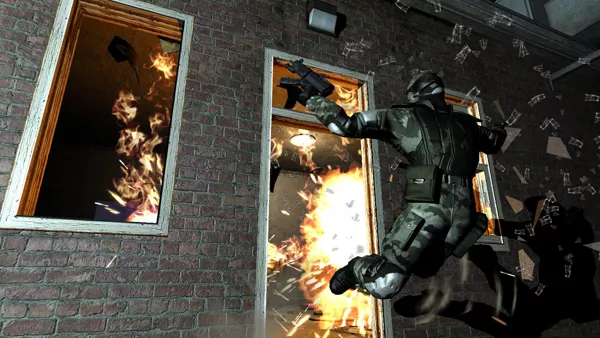F.E.A.R.: First Encounter Assault Recon
Description official descriptions
F.E.A.R.: First Encounter Assault Recon is a horror first person shooter (FPS) that resembles a cross between Doom 3, Half-Life, and the Ring horror movies. Demons are replaced by cloned soldiers and the element of horror revolves around an image of a spectral girl always appearing when least expected for a few fleeting moments.
The player sets out as a member of a specialized strike force dealing with unknown threats. Initially, the player starts with mundane weapons, which are well presented, and progress gradually towards more sci-fi ones as the danger increases. The player can also call upon a bullet-time ability which slows down time around the player and is realised with impressive visual and aural effects by the game engine.
The game takes place in a certain multi-billion aerospace installation which has been hijacked by an elite team of cloned soldiers gone rogue and an unknown supernatural force (which is likely controlling or affecting them in some way). Both threats must be identified and countered.
Spellings
- 恐惧 - Simplified Chinese spelling
Groups +
- 3D Engine: Lithtech Jupiter EX
- BestSeller Series (Cendant / Havas / Vivendi Universal) releases
- BPjS / BPjM indexed games
- Covermount: Fullgames
- F.E.A.R. series
- Games made into comics
- Middleware: Bink Video
- Middleware: PunkBuster
- Physics Engine: Havok
- Software Pyramide releases
- Technology: amBX
- Xbox 360 Platinum Hits releases
Screenshots
Promos
Videos
Add Trailer or Gameplay Video +1 point
See any errors or missing info for this game?
You can submit a correction, contribute trivia, add to a game group, add a related site or alternate title.
Credits (Windows version)
310 People (251 developers, 59 thanks) · View all
| Senior Artist, World | |
| Senior Artist/Animator | |
| Artist, World | |
| Art Director, 3D Coordinator | |
| Art Lead | |
| Senior Artist, Characters/Weapons | |
| Artist/Animator | |
| Lead Motion Capture Technician | |
| Director of Audio/Sound Designer | |
| Composer | |
| Sound Designer | |
| Level Designer | |
| Creative Director/Lead Game Designer (and Script Writer) | |
| Lead Level Designer | |
| Software Engineer (and Additional Level Design) | |
| Senior Software Engineer, AI | |
| [ full credits ] | |
Reviews
Critics
Average score: 83% (based on 78 ratings)
Players
Average score: 3.9 out of 5 (based on 158 ratings with 7 reviews)
Once upon a time, a girl named Alma...
The Good
After a brilliant career in the army, thanks to your special abilities (you can be very fast), you've joined the First Encounter Assault Recon or F.E.A.R., usually sent when things go wrong... but not in the way expected. If you prefer, the F.E.A.R. is used to interventions involving paranormal. Anyway, you're the rookie in the unit but not for so long as your first mission is to arrest a psychopath named Paxton Fettel, a psychic used as a lab rat since his birth for leading Replikas by the mind. Replikas are just genetically modified soldiers who can hear orders in their heads by the mind. Fettel escapes from his jail and uses this army to kill everyone involved in the project or everyone who will try to resist him. Unfortunately for you, a young girl named Alma seems to side with Fettel but you can kill her, she's like a ghost... You will try to solve the mystery behind Alma, Fettel and Armacham... And why do you keep to see your birth and your mother's scream when you're taken from her? Why the man is saying that you'll be a god among the humans? And why do you have the feeling that you're tied to Armacham, Fettel and Alma?
F.E.A.R. is a FPS released in 2005 who was a success, mainly because of its ambiance and plot. I mean, as you can see, you're a nameless soldier (nicknamed Pointman by the community) sent to arrest a psychic who has gone mad and killed a lot of people with his army. Well, the dead are from Armacham Technologies... When will the enterprises learn that playing with paranormal is dangerous?
Anyway, without revealing the end of the game (it's for the Extraction Point review - but in a game like FEAR, it's very difficult not to spoil everything), what looked like a simple mission will transform in a raging war between the Delta Force, the ATC guards, Fettel and his army and you. Fortunately, the Delta Force is siding with you but it seems that that Armacham wasn't really a clean corporation. Using a young girl named Alma, who appears in your mind when you don't expect it, to give birth to genetically babies (well, there are only two: the first prototype et Fettel) who can be psychic like her and imprisoning her in a sort of jail isn't very ethical, especially for Harlan Wade, the responsible of the project. Is it a mother's wrath? But why this little girl, Alma, seems to warn you sometimes about dangers?
As you can see, you will have a lot of questions in mind... and it will be in this context that you will learn more about yourself. Story is sad, hurtful and that's why it's one of the strongest points of the game.
With Half-Life and Doom 3, FEAR is one of my favorite games in terms of story. The results at the end are very interesting and even if Monolith wants to pretend that the expansion pack Extraction Point must be ignored, FEAR has one of the strongest universes for me but only if you count Extraction Point (and probably Perseus Mandate I didn't play).
Gameplay is simple. You have to shoot enemies, mainly Replikas and then ATC guards (Armacham has a lot of secrets). But shooting while running like a mad dog into enemies isn't the right solution here. You have to be careful, using the environment at your advantage. After all, you have a special power, a sort of bullet time: time is slowed while you have still the same speed. It's very useful when you're fighting against the EVE robots or a bunch of soldiers.
One of the features of this gameplay is the fact that you can only carry three weapons. So, you have to make some choices and you never know if it's right or not. It adds to the realistic part of the game but for me, it's not really a good point.
Your path is very linear but in the end, you forget about it. True, the passage in Armacham offices are long and somewhere boring but you'll find a lot of clues about the case and it's also strengthening the ambiance: you'll be scaried, oppressed by the small space and you will never know what will happened. You will never know when Paxton will trigger your memories or a vision, you will never know when Alma will appear.
Enemy AI is very good. The Replikas can duck, take cover or try to ambush you in order to kill you. Yes, everyone know that at the end, you'll be victorious (I hope) but having played games where the enemies do not see you even when you're in their eyesight or enemies running at you, making their death an easier task, I can assure you that FEAR can give some hard work to the hero.
Characters encountered are also very important: Jankowsky, your colleague, seems to have been killed in the beginning but you keep to encounter him, as if he was a ghost for example. Or Alice Wade, who prefers to escape because of her fear of flying and tries to find her father, leading you to him. Or Harlan Wade, the man who said to you that you'll be a god among the humans in your vision, who knew Alma, who was aware of what would happened, should the chamber opened (and Armacham PDG didn't seem to share his opinion). Or Paxton Fettel, your opponent, who doesn't kill you (even if he sent Replikas after you) and wants to explain to you everything. Or Alma, this young girl who seems to kill people (but you, you escape... well, you will understand why). Or Alma the Older who wants to kill you because she's angry and bitter.
Graphics are also very good. The engine is really performant and you can tell that the feeling of fear is coming primary from the game between light and shadow, between the old structures you're visiting and the technologies encountered. Enemies, despite being based on the same model, are very well designed, like the weapons (I love the futuristic sniper weapon for example, very efficient against Replikas). Your visions are also very well designed.
Soundtrack is excellent, I loved the beginning track during the sequence where Alma takes the control of Paxton's mind. You can sense the drama... like when Harlan will release Alma and is ready to pay the price of his sinful actions.
In terms of lifetime, a good replay value, difficulty modes and multiplayer justify a high thumb up from me. You know, that feature of carrying 3 weapons only will probably push some of the players to play the game but with different weapons. And then, it's also a long game, sometimes too long (Armacham is a good example). But it's worthy.
The Bad
It's very difficult to find negative points when a game like that takes you really in a dark and coherent world. For example, I'm sure that I would have found some flaws in the multiplayer mode but being not interested in this feature, I can't speak about it.
Anyway, my first complaint is about the three-weapons things. I like having all my weaponry on me, just for having the right gun at the right time. Making a choice isn't for me. Making a choice when you have more than three favorite weapons is frustrating. Yes, there is a cheat code allowing you to carry everything. And well, sometimes, having all the weapons can be useful in some cases. Anyway, even if it's probably a good thing - Vietcong for example doesn't let you use more than your primary and secondary weapon and if you want to change it, you have to throw away what you're carrying and well, it wasn't bothering me -, I don't like this system in F.E.A.R..
I didn't like the design of Alma the Older - the adult Alma who died long ago. She seems so creepy and wants really to kill you... where Alma in her younger form seems not willing to do this task. The story will tell you why and Extraction Point, the add-on, will go further in this matter.
As I've stated, if you love open spaces and movement liberty, you will not love FEAR. It's very linear, rare are the open spaces as the rule here is small spaces for more "fear", I mean, strenghtening the plot and the ambiance. But the Armacham offices level is way too long.
The Bottom Line
I wanted FEAR when I saw previews. It took one year after the buying act for playing it (remember that I've bought Painkiller when it was released and only play it two years later). And I enjoyed the game (minus the three weapons things). It's a very good game with a good ambiance, interesting weapons, a strong storyline and the emblem which is Alma, reminding the little girl from The Ring.
So, my bottom line is: buy it, you'll be not disappointed!
Windows · by vicrabb (7272) · 2008
The Good
The game incorporates most popular and proven things of its time. They are: 1) military combat very popular thankfully to Counter-Strike franchise, 2) Japanese horror critically acclaimed in 'The Ring' movies and its American re-makes, and 3) the talents of the developers from Monolith. The blend of such things gave the "F.E.A.R.".
Horror in the game was raised to the very high point. The plot is composed by you mostly not based on the straight-forward story-telling, but on the phone calls and laptop data you've discovered along your way. Some of the dead bodies are cannibalized and shown to you to scare you, but some of them are hidden, and you may find them if you want tracking the blood spots. The game is very bloody and the plot was scary even for me.
The music and sound effects are very atmospheric. The action is very challenging. Since the very beginning, you should be ready to the full hard contact with different enemies as soldiers in real world as paranormal creatures in your hallucinations.
The Bad
The game is very straight-forward. You should run mostly on only one road and it doesn't give the freedom to the player. Too much questions were left after the game finish than the answers were taken. Sequel should cast the light on several issues, but not on all, I guess. But also I guess that it was a twist of the designers to make the game in such way. You will not replay the game to revive the memories, for sure. These memories are too terrific to revive them. Instead of it you have a multiplayer option, if you want to play this game once more.
Some of the weapons are useless during the game. The shotgun was almost not used by me as well as mini-guns, but it is personal preference. However, I've played Extraction Point (the game's add-on), where shotgun was my one of the best weapons during 2nd Interval instead, but I'll review the add-on later.
It is definitely, that the game is not NOLF2 with all its best parts, but it is solid (yeah, I've remembered Metal Gear Solid, it is also Japanese and also military and slightly paranormal based game) action. Some of the plot twist are not clear for me. For example, why you've killed Paxton Fettel so easily, and why you have killed him at all? Why Alma've killed her creator and Alice? I've guessed that answer will be that Paxton should be dead because it was your main mission goal during most of the Intervals and that Alma is a monster who should killed her creator, but who knows...
I wrote much letters in this section, but I didn't think that game is bad at all. It is great, instead.
The Bottom Line
The game is a solid horror military Delta Force-based shooter, where you as shoot the enemies in challenging combat as untwist the story (if you want to). It should be played for the FPS fans, for sure. It should be played by adventure game genre fans also, because the story is not so simple as it seems, and the plot will capture your imagination and put it in a real-life's nightmare.
Windows · by POMAH (66427) · 2008
The Good
Uber developer, Monolith, has a long track record of high quality games. From the Doomesque, Lovecraft influenced FPS‘, Blood and Blood 2: The Chosen. To the zany spy shooters No One Lives Forever, and it’s sequel. Recently Monolith has gone back to it’s horror game roots, with the trailblazing horror series Condemned. And it’s “sister” franchise F.E.A.R.. Can Monolith strike gold yet again?
F.E.A.R., or First Encounter Assault Recon, is an elite group of soldiers trained to deal with the paranormal. You play as the newest member of the squad, a mysterious character with uncanny agility and strength, known only as the “pointman”.
“It is the way of men to create monsters. And it is the nature of monsters to destroy their creators.”
When the psycho killer, Paxton Fettel, escapes from his high security prison, F.E.A.R. is contacted to stop him. It seems that Fettel has some kind of psychic link with replica soldiers, these automatons will do anything to stop you. They feel no fear, no remorse, and cannot be reasoned with.
To make matters worse you keep seeing the ghost of a little girl in a red dress. And there is trouble at the arms manufacturer Armacham and something called project origin, can there be a connection?
F.E.A.R. is a first person shooter, with horror elements.(Like Half-life, or System Shock-MM-) And it can be quite creepy and unsettling, but it’s not quite as scary as say, Condemned. This is achieved largely by the great atmosphere.
There are lots of scripted scares. Including a really cool sequence with the pointman being haunted by a former F.E.A.R. agent. There is also the System Shock esque, use of messages you hear on answering machines, these help fill in the story and can be quite creepy.
I would like to now take the time to set the record strait on one of the biggest misconceptions of F.E.A.R. Every tom, dick, and harry, says that F.E.A.R. is like a Japanese horror movie. When it’s really not. The only element that is like a Japanese horror movie is the ghost of the little girl, but unlike crappy movies like “Dark Water” it actually makes sense in F.E.A.R. Furthermore this game is actually scary.
It also takes techniques from American horror films, namely John Carpenter films such as, Halloween. And even Italian and French horror films.
“You will be a god among men.”-Harlen Wade-
The graphics in F.E.A.R. are good. Not great, just good. Keep in mind that this game was released initially in 2005 for the PC, and a launch game for the 360. It looks better in HD, but it’s no Bioshock or Mass Effect.
The sound department is really were it’s at in F.E.A.R. The voice acting is all top notch. And the music is eerie and helps establish the mood. The gun effects are all accurate and sound great. But it is the creepy sound effects that steal the show, from the cues when you see something strange, to the screams and cries of the damned.
The Bad
The difficulty settings seem to be a bit askew. Easy offers almost no challenge, Medium is oft to hard, and the other two settings are just about impossible.
The auto aiming is dubious at best, and unnecessary. The critical attacks are very cool however.
Sometimes you can get stuck in walls. And even worse there is a bug where your guns disappear, and you must load to correct it.
I am also not a fan of the checkpoint save system. I prefer the good old days when you could save whenever you wanted. Or at least meet me halfway and have manual and autosaves. With this checkpoint nonsense, you can only quit when you get a checkpoint.(Thanks a lot Halo.-MM-)
The Bottom Line
“He deserved to die, they all deserve to die.”-Paxton Fettel-
Overall F.E.A.R. is a great game. And one of my favorite FPS games. It has the perfect mix of action and horror. Now I’m off to play the two expansions Extraction Point, and Perseus Mandate. And I am already looking forward to 2009’s Fear 2: Project Origin.
Xbox 360 · by MasterMegid (723) · 2008
Trivia
1001 Video Games
The PC version of F.E.A.R. appears in the book 1001 Video Games You Must Play Before You Die by General Editor Tony Mott.
ATC
Armacham first appeared in Shogo: Mobile Armor Division, and it might be that the F.E.A.R. universe is somehow connected to that series. In Shogo, Armacham manufactures the Ordog Advanced Series 7 Mobile Combat Armor.
Console version
In the console versions, blood textures on killed characters and the environment were removed. For the Xbox 360 version, this was later revoked with a patch.
Development
The game was originally going to have a car chase scene and even had extensive drafting during the development. However, it was removed during further development, as in the words of Craig Hubbard, "It didn't work out the way we hoped it would." The car originally used for the chase sequence did make it into the final game, though in limited capacity: it is the same vehicle that the character Rowdey Betters drives the protagonist into the first level with.
Douglas Holiday
The Delta Force operative Douglas Holiday was originally going to be a member of the F.E.A.R. Team. This can be seen in pre-release trailers and promotional pictures of the game.
German version
In the German version, all gore effects and the skeleton after killing an enemy with the energy weapon were removed. Enemies still bleed when being shot, but the blood does not spray on the environment.
Inspiration
F.E.A.R. is heavily inspired by Japanese horror films like Ringu (The Ring) and Ju-on (The Grudge). For instance, the mysterious girl with long black hair is obviously channeling Samara from The Ring.
Online servers
The game's online servers which were hosted on GameSpy were shut down on 5 December 2012.
P.A.N.I.C.S.
To promote the game prior to the release, Vivendi Universal sponsored a machinima viral campaign called P.A.N.I.C.S. - produced by BeSeen Communications and Rooster Teeth Productions (famous for Red vs. Blue).
The title is short for People Acting Normal in Crazy-ass Situations and it was a series produced utilizing the machinima technique generated by the F.E.A.R. game engine. The story offers a humorous look at the escapades of Bravo Team as they face off against an unseen, supernatural opponent. In addition to the four installments released to the public, a fifth "prequel" episode was included as a bonus feature in the Director's Edition.
The series was awarded with the "IFCTM Award for Excellence in Machinima Screenwriting" sponsored by the Independent Film Channel and nominated for two other awards at the 2005 Academy of Machinima Arts & Sciences Film Festival, including Best Series and Best Commercial Machinima.
References
- During Interval 6, at a security checkpoint where you first encounter a particular enemy, look for a letter on the desk. The letter in question, is addressed to Monolith Productions, the developer of the game.
- A long-running joke in the No One Lives Forever series was the fact that in neither game it was revealed what H.A.R.M. actually stood for, even though it was referred to plenty of times ("Remember what H.A.R.M. stands for!"). In F.E.A.R. one can see the H.A.R.M. logo on a sign on a warehouse wall early in the game, with the words "Heater And Refridgerator Manufacturing" printed on it.
- The name of the character Jin Sun-Kwon may be a reference to the name of the Lost TV series characters Jin-Soo Kwon and Sun. It is also notable that both characters from the TV series and the one from the game are Koreans.
- Throughout the labs in the Armacham HQ and the Origin facility, one can see many "8311 XHT" model fume hoods. This could be a reference to the 1971 science fiction film THX 1138.
- A. Shephard, a Delta Force coordinator who is only heard through radio transmissions, was likely named so as a nod to Adrian Shephard, the protagonist of Half-Life: Opposing Force.
References to the game
In the sitcom The IT Crowd, the character Moss is playing F.E.A.R. on the computer.
Technology
F.E.A.R. is possibly the most graphically-intensive commercial game (as of November 2005) yet. It has replaced Doom 3 as a popular benchmarking tool for companies testing new graphics cards.
Of course, all this is to the chagrin of the ordinary gamer. Some people have suggested that "FEAR" stands for F***ed Engine and Requirements.
Vending machines
Some of the vending machines that appear in the game are the exact same ones that are used in Monolith's other games: No One Lives Forever, Condemned: Criminal Origins and Condemned 2: Bloodshot.
Weapons
Many firearms in the game have a real-life counterpart. The RPL SMG is based on the MP5, the VK12 Combat Shotgun is based on the SPAS-12, the AT-14 Pistol is based on a version of the HK USP, the G2A2 Assault Rifle is based on the HK SL8 and the ASP Rifle is an analogue of the Tavor TAR-21.
Awards
- 4Players
- 2005 – Best Action Game of the Year
- 2005 – Most Impressive Boss of the Year (for Alma)
- 2005 – Best AI of the Year
- PC Powerplay (Germany)
- Issue 04/2006 - #4 Action Game in 2005 (Readers' Vote)
Information also contributed by CaptainCanuck, dasfatso, Medicine Man, Neon Hammerite and Sciere
Analytics
Upgrade to MobyPro to view research rankings!
Related Sites +
-
What Is FEAR
Official game website
Identifiers +
Contribute
Are you familiar with this game? Help document and preserve this entry in video game history! If your contribution is approved, you will earn points and be credited as a contributor.
Contributors to this Entry
Game added by Silverblade.
Xbox 360, PlayStation 3 added by Sciere.
Additional contributors: Unicorn Lynx, Sciere, Maw, Medicine Man, Patrick Bregger, Plok, FatherJack, WONDERなパン.
Game added November 2, 2005. Last modified June 6, 2024.
